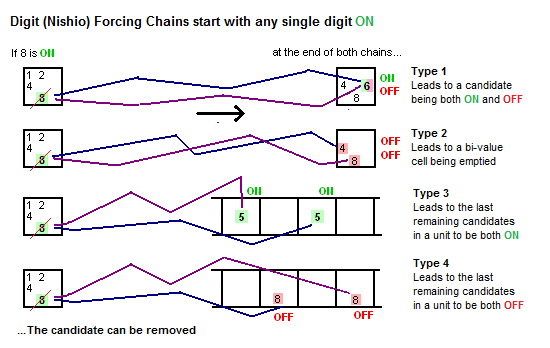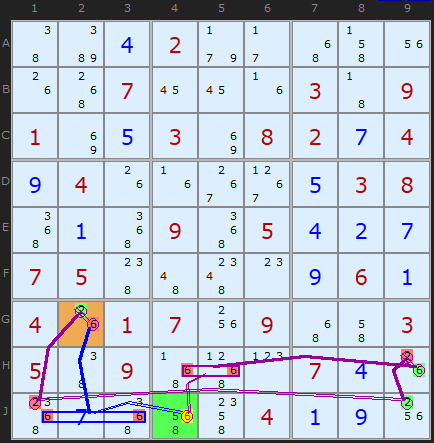Nishio Forcing Chains
Nishio has a long history in the community as a semi 'trial and error' approach to very hard Sudoku bottlenecks, but in the implementation on this website it fits very nicely into the family of forcing chains and is a formal 'pattern' based strategy that uses AICs. In fact it is very close to Digit Forcing Chains since Nishio works on a single candidate as well. Where Digit Forcing Chains take a candidate and consider the consequences of the candidate being both ON and OFF, Nishio tries to find a contradiction when the candidate is merely ON. Two chains emanate from the candidate in different directions and try to join up later on another candidate. The rule is, if the start candidate is ON and this leads to another candidate being both ON and OFF it is indicating an impossible state of affairs. So the original candidate cannot be a solution.


In this example the starting candidate is 6 in J4. The shorter blue chain simply says that when 6 in J4 is ON it removes the 6s in box 7 leaving 6 in G2 as the only remaining 6 and therefore the solution. On the other hand, the longer purple chain implies 6 cannot be the solution in G2. A 6 in J4 means 6s are removed from the rest of box 8 and that turns ON the six in H9. That forces 2 in J9 which in turn removes 2 from J1 making G2 2 and not 6.
Therefore the 6 in J4 cannot be a solution and it can be removed.

Comments
Email addresses are never displayed, but they are required to confirm your comments. When you enter your name and email address, you'll be sent a link to confirm your comment. Line breaks and paragraphs are automatically converted - no need to use <p> or <br> tags.
... by: tebo
... by: Ghost 2T
You can combine the TH supposes the series to the same article, divide it into many articles for what. (Because of the principle it is the same "true/false 1 -> true/false 2")
... by: Leren
The solver returns the first instance of the strategy used but currently cant cycle through all instances of that strategy so I'm sure other formations of the same chain are possible as it's also a loop. I'd like to allow that in the solver and it's an upgrade I have in the job queue. There is a limit on the length of normal single chain AICs which I have to impose to stop the program taking too long to return (mainly for the grading feature which has to run through all the strategies). That means that some AICs might not be found and instead two chains in the double chain strategies like Nishio get to find the same result as each chain is under the limit. I've had several goes at optimising the AIC searchs but not to any great improvement in speed.
I haven't broadened Nishio to non loop type entities because the narrow definition I've worked with has start and end points on single candidates. But I'll be the first to admit there is overlap with other chaining strategies.